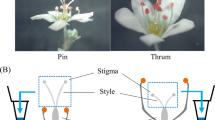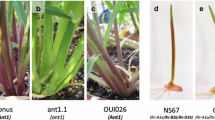Summary
The structure of the wild-type waxy (wx +) locus was determined by sequence analysis of both a genomic and an almost full-size cDNA clone. The coding region comprises 3,718 bp and is composed of 14 exons and 13 small introns. The exons and the promoter region are G/C rich (60%–80%). All three waxy transcripts analysed so far reveal different polyadenylation sites and corresponding polyadenylation signals. The smallest of these mRNAs has a size of 2,263 nucleotides. Northern blot analysis suggests that the tissue-specific expression of the locus is due to transcriptional control. The insertion sites of all transposable element induced waxy mutations analysed have been mapped precisely within the locus. N-terminal sequencing of the mature wx + protein leads to the identification of a maize amyloplast-specific transit peptide of 72 aminoacid residues.
Similar content being viewed by others
References
Behrens U, Fedoroff N, Laird A, Müller-Neumann M, Starlinger P, Yoder J (1984) Cloning of the Zea mays controlling element Ac from the wx-m7 allele. Mol Gen Genet 194:346–347
Berget SM (1984) Are U4 small nuclear ribonucleoproteins involved in polyadenylation? Nature 309:179–182
Breathnach R, Chambon P (1981) Organization and expression of eucaryotic split genes coding for proteins. Annu Rev Biochem 50:349–383
Coruzzi G, Broglie R, Edwards C, Chua NH (1984) Tissue-specific and light-regulated expression of a pea nuclear gene encoding the small subunit of ribulose-1,5-bisphosphate carboxylase. EMBO J 3:1671–1679
Dennis ES, Gerlach WL, Pryor AJ, Bennetzen JL, Inglis A, Llewellyn D, Sachs MM, Ferl RJ, Peacock WJ (1984) Molecular analysis of the alcohol dehydrogenase (adh1) gene of maize. Nucleic Acids Res 12:3983–4000
Dennis ES, Sachs MM, Gerlach WL, Finnegan EJ, Peacock WJ (1985) Molecular analysis of the alcohol dehydrogenase 2 (adh2) gene of maize. Nucleic Acids Res 13:727–743
Echt CS, Schwartz D (1981) Evidence for the inclusion of controlling elements within the structural gene at the waxy locus in maize. Genetics 99:275–284
Emerson BM, Lewis CD, Felsenfeld G (1985) Interaction of specific nuclear factors with the nuclease-hypersensitive region of the chicken adult β-globin gene: nature of the binding domain. Cell 41:21–30
Everett RD, Baty D, Chambon P (1983) The repeated GC-rich motifs upstream from the TATA box are important elements of the SV40 early promoter. Nucleic Acids Res 11:2247–2264
Fedoroff N, Wessler S, Shure M (1983) Isolation of the transposable maize controlling elements Ac and Ds. Cell 35:235–242
Fuwa H (1957) Phosphorylase and Q-enzyme in developing maize kernels. Arch Biochem Biophys 70:157–168
Hager DA, Burgess RR (1980) Elution of proteins from sodium dodecyl sulfate-polyacrylamide gels, removal of sodium dodecyl sulfate, and renaturation of enzymatic activity: Results with sigma subunit of Escherichia coli RNA polymerase, wheat germ DNA topoisomerase, and other enzymes. Anal Biochem 109:76–86
Henikoff S (1984) Unidirectional digestion with exonuclease III creates targeted breakpoints for DNA sequencing. Gene 28:351–359
Klenow H, Henningsen I (1970) Selective elimination of the exonuclease activity of the deoxyribonucleic acid polymerase from Escherichia coli B by limited proteolysis. Proc Natl Acad Sci USA 65:168–175
Kozak M (1984) Compilation and analysis of sequences upstream from the translational start site in eucaryotic mRNAs. Nucleic Acids Res 12:857–872
Laemmli UL (1970) Cleavage of structural proteins during the assembly of the head of bacterophage T4. Nature 227:680–685
Land H, Grez M, Hauser H, Lindenmaier W, Schütz G (1981) 5′ terminal sequences of eucaryotic mRNA can be cloned with high efficiency. Nucleic Acids Res 9:2251–2266
Maniatis T, Fritsch EF, Sambrook J (1982) Molecular cloning: a laboratory manual. Cold Spring Harbor Laboratory, Cold Spring Harbor, New York, USA
Mazur BJ, Chui CF (1985) Sequence of a genomic DNA clone for the small subunit of ribulose bis-phosphate carboxylase-oxygenase from tobacco. Nucleic Acids Res 13:2373–2386
McClintock B (1951) Chromosome organization and genic expression. Cold Spring Harbor Symp Quant Biol 16:13–47
McClintock B (1954) Mutations in maize and chromosomal aberrations in neurospora. Carnegie Inst Wash Year Book 53:254–260
McClintock B (1961) Further studies of the Suppressor-Mutator system of control of gene action in maize. Carnegie Inst Wash Year Book 60:469–476
McClintock B (1963) Further studies of gene-control systems in maize. Carnegie Inst Wash Year Book 62:486–493
McClintock B (1964) Aspects of gene regulation in maize. Carnegie Inst Wash Year Book 63:592–602
McClintock B (1965) The control of gene action in maize. Brookhaven Symp Biol 18:162–184
McDevitt MA, Imperiale MJ, Ali H, Nevins JR (1984) Requirement of a downstream sequence for generation of a poly(A) addition site. Cell 37:993–999
McKnight SL, Kingsbury R (1982) Transcriptional control signals of a eucaryotic protein-coding gene. Science 217:316–324
McLauchlan J, Gaffney D, Whitton JL, Clements JB (1985) The consensus sequence YGTGTTYY located downstream from the AATAAA signal is required for efficient formation of mRNA 3′ termini. Nucleic Acids Res 13:1347–1368
Mount SM (1982) A catalogue of splice junction sequences. Nucleic Acids Res 10:459–472
Müller-Neumann M, Yoder JI, Starlinger P (1984) The DNA sequence of the transposable element Ac of Zea mays. Mol Gen Genet 198:19–24
Nelson OE (1968) The waxy locus in maize. The location of the controlling element alleles. Genetics 60:507–524
Nelson OE, Rines HW (1962) The enzymatic deficiency in the waxy mutant of maize. Biochem Biophys Res Commun 9:297–300
Nevers P, Shepherd NS, Saedler H (1985) Plant transposable elements. Adv Bot Res 12:102–203
Nevins JR (1983) The pathway of eucaryotic mRNA formation. Annu Rev Biochem 52:441–466
Norrander J, Kempe T, Messing J (1983) Construction of improved M13 vectors using oligodeoxyribonucleotide-directed mutagenesis. Gene 26:101–106
Pereira A, Schwarz-Sommer Zs, Gierl A, Bertram I, Peterson PA, Saedler H (1985) Genetic and molecular analysis of the Enhancer (En) transposable element system of Zea mays. EMBO J 4:17–23
Peterson PA (1953) A mutable pale green locus in maize. Genetics 38:682–683
Peterson PA (1965) A relationship between the Spm and En control system in maize. Am Nat 99:391–398
Pohlman RF, Fedoroff NV, Messing J (1984) The nucleotide sequence of the maize controlling element Activator. Cell 37:635–643
Poncz M, Solowiejczyk D, Ballantine M, Schwartz E, Surrey S, (1982) “Nonrandom” DNA sequence analysis in bacteriophage M13 by the dideoxy chain-termination method. Biochemistry 79:4298–4302
Proudfoot NJ, Brownlee GG (1976) 3′ non-coding region sequences in eucaryotic messenger RNA. Nature 263:211–214
Saedler H, Nevers P (1985) Transposition in plants: a molecular model. EMBO J 4:585–590
Sanger F, Nicklen S, Coulson AR (1977) DNA sequencing with chain-terminating inhibitors. Proc Natl Acad Sci USA 74:5463–5467
Schwarz-Sommer Zs, Gierl A, Klösgen RB, Wienand U, Peterson PA, Saedler H (1984) The Spm (En) transposable element controls the excision of a 2 kb DNA insert at the wx-m8 allele of Zea mays. EMBO J 3:1021–1028
Schwarz-Sommer ZS, Gierl A, Berndtgen R, Saedler H (1985a) Sequence comparison of ‘states’ of a1-m1 suggests a model of Spm (En) action. EMBO J 4:2439–2443
Schwarz-Sommer ZS, Gierl A, Cuypers H, Peterson PA, Saedler H (1985b) Plant transposable elements generate the DNA sequence diversity needed in evolution. EMBO J 4:591–597
Shure M, Wessler S, Fedoroff N (1983) Molecular identification and isolation of the waxy locus in maize. Cell 35:225–233
Sprague GF, Brimhall B, Hixon RM (1943) Some effects of the waxy gene in corn on properties of the endosperm starch. J Am Soc Agron 35:817–822
Tsai CY (1974) The function of the waxy locus in starch synthesis in maize endosperm. Biochem Genet 11:83–96
Vieira J, Messing J (1982) The pUC plasmids, an M13 mp7-derived system for insertion mutagenesis and sequencing with synthetic universal primers. Gene 19:259–268
Vodkin LO, Rhodes PR, Goldberg RB (1983) The cA lectin gene insertion has the structural features of a transposable element. Cell 34:1023–1031
Wasylyk B, Derbyshire R, Guy A, Molko D, Roget A, Teoule R, Chambon P (1980) Specific in vitro transcription of conalbumin gene is drastically decreased by single-point mutation in TATA box homology sequences. Proc Natl Acad Sci USA 12:7024–7028
Weiher H, König M, Gruss P (1983) Multiple point mutations affecting the Simian Virus 40 enhancer. Science 219:626–631
Werr W, Frommer WB, Maas C, Starlinger P (1985) Structure of the sucrose synthase gene on chromosome 9 of Zea mays L. EMBO J 4:1373–1380
Wessler SR, Varagona MJ (1985) Molecular basis of mutations at the waxy locus of maize: correlation with the fine structure map. Proc Natl Acad Sci USA 82:4177–4181
Wieringa B, Hofer E, Weissmann C (1984) A minimal intron length but no specific internal sequence is required for splicing the large rabbit β-globin intron. Cell 37:915–925
Author information
Authors and Affiliations
Additional information
Communicated by P. Starlinger
Rights and permissions
About this article
Cite this article
Klösgen, R.B., Gierl, A., Schwarz-Sommer, Z. et al. Molecular analysis of the waxy locus of Zea mays . Molec Gen Genet 203, 237–244 (1986). https://doi.org/10.1007/BF00333960
Received:
Issue Date:
DOI: https://doi.org/10.1007/BF00333960




